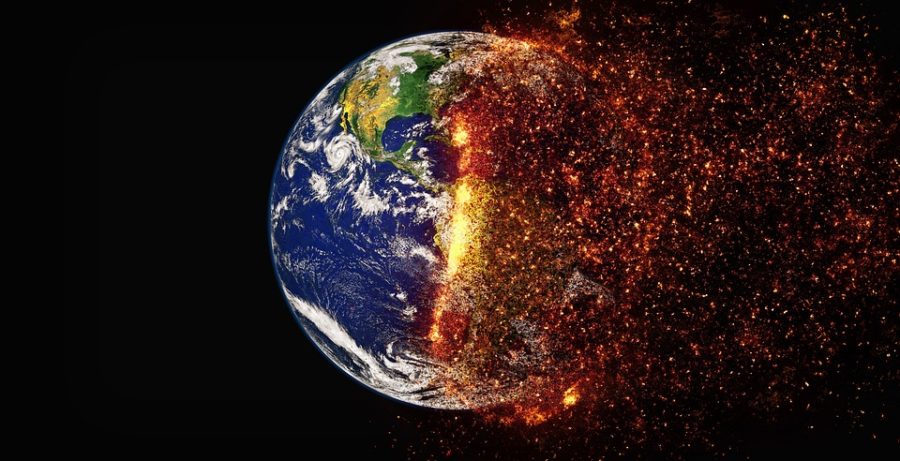The Facts About Climate Change
The Earth’s climate is always changing, adapting to human advancements and changing weather patterns. However, in the last two decades, Earth’s average temperature has begun to rise at a much faster pace. According to NASA, the planet’s average surface temperature has risen about 1.62 degrees Fahrenheit.
This number may seem minuscule, however, its affects have been drastic worldwide.
It’s estimated that 95 percent of this warming pattern has been caused by human activity.
The most apparent cause is the increase of greenhouse gasses in Earth’s atmosphere. According to the United States Environmental Protection Agency, the three main greenhouse gasses contributing to this warming trend are carbon dioxide, methane and nitrous oxide.
These gasses exacerbate a natural process known as the Greenhouse Effect. This occurs when the sun’s energy reaches Earth’s atmosphere. Some of this energy is absorbed into the atmosphere and re-radiated as greenhouse gasses while simultaneously warming Earth says the Department of the Environment and Energy. The rest of this energy is reflected back into space.
Science teacher Scott Newel added, “The main causes of Global Warming are human activities and the increase in burning fossil fuels.”
Over the last century, the increase in the use of fossil fuels has created an influx of atmospheric carbon dioxide.
The five warmest years on record have taken place since 2010, with 2016 being the warmest.
This trapped heat needs a place to go, so it seeps into Earth’s oceans and soil. Warmer oceans speed up evaporation which, in turn, leads to increased precipitation. Warmer oceans are also melting ice sheets in the Arctic.
NASA’s Gravity Recovery and Climate Experiment showed that between 1993 and 2016, Greenland lost an average of 281 billion tons of ice per year, while Antarctica lost about 119 billion tons.
“I think people are aware [of climate change] but that doesn’t seem to be making a difference,” said Newell.
In the United States, climate change has become hard to ignore.
“I think many people remain unaware and/or they are not educated in the science. For this reason I think the most important class everyone should take is Environmental Science, be it general Environmental Science or AP,” said biology teacher Cris Robson when explaining what Air Academy students could do to become more involved.
“I think many people know OF climate change but I don’t think many people are aware of how detrimental the consequences are or know of specific alternatives that could slow the effects,” said AP environmental science student Shannon Spahr.
Starting in 2016, temperatures in Chicago reached below temperatures on Mars, making it one of the coldest places on the planet–colder than Antarctica and the South Pole.
But why is cold weather so extreme if the Earth is warming?
These record lows are a reflection of weather and the conditions in a certain place over a short period of time. The warming pattern is a reflection of climate, atmospheric patterns over a long period of time.
“I like to refer to it as ‘climate change’ rather than ‘global warming’, because while it is true that the Earth’s median temperature is rising, there are some areas on the earth that are experiencing cooling, and some people who are uneducated in science believe that since some areas are cooling, climate change is not happening,” explained Robson.
The importance of trying to stop these drastic changes has been a political hot topic.
The Intergovernmental Panel on Climate Change (IPCC) stresses the importance of the unknown. These scientists state the unpredictability of climate change and how it’s affects could be worse than anyone could’ve imaged.
Robson is doing her part to preserve the well-being of the Earth.
“I live in an Earth Berm house [mostly underground]. Because we live in this type of house, we do not use central heat or air. We rely on passive solar for much of our heating. I also purchase as many recycled products as possible, as well as products without additives that harm the environment,” she said.
The Natural Resources Defense Council emphasizes the significance of civilian contributions to this issue. They state that by powering your home with renewable energy, reducing water waste and driving fuel-efficient vehicles carbon dioxide emissions would significantly decrease.
“It’s affecting us on a micro-scale with things such as pollution,” explained Newell. “It’s affecting our quality of life.”
Climate change not only encompasses rising average temperatures, but also includes extreme weather events, rising sea levels and shifts in wildlife populations and habitats says National Geographic.
This human-induced trend has already created havoc for many, but who knows what damage is left to be done.

Wassup! My name is Casey Hogan and I am finally a senior. This is my second year writing for the Jetstream Journal and first year as a Copy Editor. I...

















